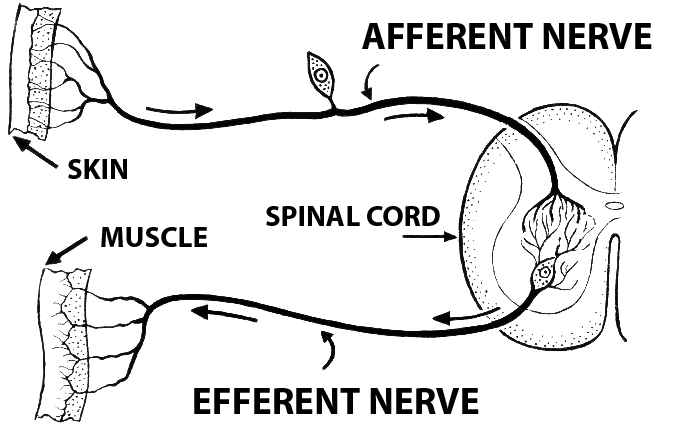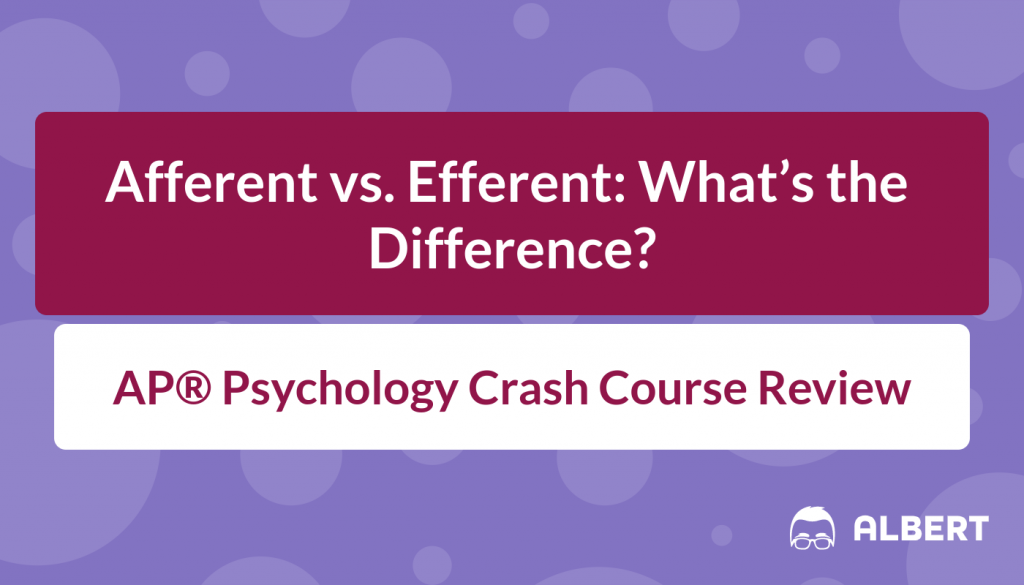The AP® Psychology course covers 14 key topics and fields of study in psychology, and the AP® exam will test your knowledge of all of them. It can be exhausting to process all the information expected of you for the AP® Psych exam. Luckily for you, we have broken down the key concepts you need to know to score a 4 or 5 in May. This AP® Psychology Crash Course will review a tricky topic and make it simple: the difference between afferent and efferent neurons.

Image Source: Wikimedia Commons
Afferent vs. Efferent: What’s the Difference?
With such similar-sounding words, it can be tough to remember the difference between afferent and efferent. That’s why it’s important to focus on the difference in what they do first. Plus, we’ll give you tips on how to remember and master this distinction in time for the AP® psych exam.
Afferent neurons – also called sensory neurons – are the nerves responsible for sensing a stimulus. Then, they send information about that stimulus to your central nervous system. Sensory input, such as smells and feelings of pain, is carried from the point of reception up the spinal cord and into the brain.
Efferent neurons – also called motor neurons – are the nerves responsible for carrying signals away from the central nervous system in order to initiate an action. When sensory input is brought to the brain, it sends signals for a motor response to your muscles and glands via the efferent neurons.
A third type of neuron, called the interneuron or association neuron, acts as a kind of middleman between the afferent and efferent neurons. These neurons are located in the central nervous system (the brain and spinal cord). Afferent and efferent neurons have to work together in order to sense and respond to stimulus, but they don’t directly connect. Association neurons bridge the gap to relay information between sensory and motor neurons.
You can think of afferent and efferent neurons pathways as one-way streets. The traffic can only flow in one direction – afferent neurons only take information to the central nervous system, and efferent neurons only take it away from the central nervous system. The association neurons are like the intersection where they meet.
Need another way to remember the difference? A comes before E in the alphabet. The afferent neurons have to receive the sensory information before the efferent neurons can respond to it. After all, if we sit on a pin, we can’t jump up in surprise if we don’t feel the pinprick in the first place.
Why is it important?
Afferent and efferent neurons are part of your somatic nervous system, which is responsible for all the voluntary muscle movements in your body. When you kick a ball, scratch your head, or do push-ups at the gym, afferent and efferent neurons are evaluating stimuli and allowing you to respond. Interneurons, on the other hand, are part of the central nervous system.
Think of when you check your refrigerator to see if the milk has gone bad. You open the gallon jug and put your nose up to it. When you sense that rotten smell, you immediately pull away and put the jug as far away from you as possible.
What in the nervous system is at work here?
Afferent neurons are responsible for you sensing the rotten smell of the milk. They send that information up the spinal cord to your brain, where association neurons decide how to respond. Then, those association neurons tell the efferent neurons the plan, and the information travels down your spinal cord and out toward your muscles, telling them to pull away and put the jug down.
What You Need to Know for the AP® Psychology Exam
Afferent, efferent, and interneurons fall under the category Biological Bases of Behavior, which according to the College Board makes up 8-10% of multiple-choice section of the AP® Psych exam.
Knowledge of both the central and peripheral nervous systems is crucial for success on the AP® Psychology exam. You should review the basic processes and systems that biologically cause certain behaviors. Psychology is not just about mental processes, but also about how our behaviors are physically produced.
With such a large portion of the exam dealing with the nervous system, understanding the difference between and the functions of afferent and efferent neurons is crucial. These neurons are the basis for knowing how the central and peripheral nervous systems fundamentally work. You should be able to discuss their function in sensation and perception of stimuli, and how they cause your body to respond biologically to different sensations. You should also be able to discuss the transmission of signals between neurons.
Questions about neural transmission – including among afferent and efferent neurons – could appear in the multiple-choice section of the AP® psych exam.
Keep this in mind: any of the names for these neurons could appear on the AP® Psychology exam. That means afferent neurons could be referred to as sensory neurons, and association neurons could be called interneurons. Feel free to use whichever terms are easier for you while you’re reviewing. However, make sure you’ll be able to recognize any of the other names when exam day comes.
Here is an example of a multiple choice question that could appear on the AP® Psych exam:
Which of the following is the correct sequence of neural communication from sensory input to triggering a muscle response?
(A) Efferent neurons; Afferent neurons; Interneurons
(B) Interneurons; Efferent neurons; Afferent neurons
(C) Afferent neurons; Interneurons; Efferent neurons
(D) Efferent neurons; Interneurons; Afferent neurons
(E) Interneurons; Afferent neurons; Efferent neurons
Correct Answer: C. First, afferent neurons receive sensory information from an external stimulus. That information is then sent into the interneurons of the central nervous system. In turn, the interneurons communicate information to the efferent neurons, which send information to the appropriate portion of the body and trigger a physical response.
With this AP® Psychology Crash Course on hand for review, you’re well on your way to mastering the key physiological processes that will appear on the AP® Psych exam. Once you have these basics down, you can build your psychology skill set and tackle the AP® exam with confidence.
Let’s put everything into practice. Try this AP® Psychology practice question:
Looking for more AP® Psychology practice?
Check out our other articles on AP® Psychology.
You can also find thousands of practice questions on Albert.io. Albert.io lets you customize your learning experience to target practice where you need the most help. We’ll give you challenging practice questions to help you achieve mastery of AP Psychology.
Start practicing here.
Are you a teacher or administrator interested in boosting AP Psychology student outcomes?
Learn more about our school licenses here.










4 thoughts on “Afferent vs. Efferent: What’s the Difference? AP® Psychology Crash Course Review”
Wow I’m soooo happy to read through your article.
So glad it helped!
This was extremely helpful.
That’s great to hear! Glad it was so helpful 🙂
Comments are closed.